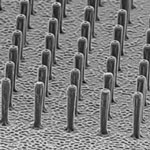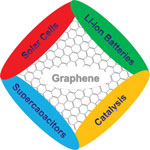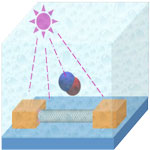Showing Spotlights 1489 - 1496 of 2780 in category All (newest first):
 In the past couple of decades, thermoelectrics have been drawing more and more research interest due to the limited availability and the negative environmental impact of conventional energy strategies. In the past, as a measuring stick of the conversion efficiency, the term "dimensionless figure-of-merit," also referred to as ZT, has been widely used. A high ZT value usually promises high thermoelectric performance. Typically, good thermoelectric materials should simultaneously display low thermal conductivity and good electrical conductivity. Striving to enhance the performance of thermoelectric materials, researchers from Boston College and MIT have recently reported a novel materials design to achieve a 30 to 40% enhancement in the peak ZT value for n-type SiGe semiconducting alloys.
In the past couple of decades, thermoelectrics have been drawing more and more research interest due to the limited availability and the negative environmental impact of conventional energy strategies. In the past, as a measuring stick of the conversion efficiency, the term "dimensionless figure-of-merit," also referred to as ZT, has been widely used. A high ZT value usually promises high thermoelectric performance. Typically, good thermoelectric materials should simultaneously display low thermal conductivity and good electrical conductivity. Striving to enhance the performance of thermoelectric materials, researchers from Boston College and MIT have recently reported a novel materials design to achieve a 30 to 40% enhancement in the peak ZT value for n-type SiGe semiconducting alloys.
Apr 25th, 2012
 Graphene with its distinctive band structure and unique physiochemical properties - such as exceptionally low intrinsic electrical resistivity, high surface area, rapid electrode kinetics and good mechanical properties - is considered an attractive material for analytical electrochemistry. However, one of the key technical challenges for the use of graphene as functional material in device applications is the integration of nanoscale graphene onto micro- or millimeter sized sensing platforms. With a new methodology, a team from Florida International University was able to integrate graphene onto three-dimensional (3D) carbon microstructure arrays with good uniformity and controllable morphology.
Graphene with its distinctive band structure and unique physiochemical properties - such as exceptionally low intrinsic electrical resistivity, high surface area, rapid electrode kinetics and good mechanical properties - is considered an attractive material for analytical electrochemistry. However, one of the key technical challenges for the use of graphene as functional material in device applications is the integration of nanoscale graphene onto micro- or millimeter sized sensing platforms. With a new methodology, a team from Florida International University was able to integrate graphene onto three-dimensional (3D) carbon microstructure arrays with good uniformity and controllable morphology.
Apr 24th, 2012
 Counterfeiting of bank notes has always been a problem and central banks are leading a high-tech fight against sophisticated counterfeiting operations. For instance, when the European Central Bank designed its new banknotes, they included a variety of security features - holograms, foil stripes, special threads, microprinting, special inks and watermarks. Another high-tech approach are imprinting radio frequency identification (RFID) tags onto banknotes. While the integration of RFID technology on a banknote is technically possible, no banknotes in the world today employ such a technology. In recent work, researchers in Saudi Arabia have now fabricated the first-ever all-polymer, non-volatile, ferroelectric memory on banknotes.
Counterfeiting of bank notes has always been a problem and central banks are leading a high-tech fight against sophisticated counterfeiting operations. For instance, when the European Central Bank designed its new banknotes, they included a variety of security features - holograms, foil stripes, special threads, microprinting, special inks and watermarks. Another high-tech approach are imprinting radio frequency identification (RFID) tags onto banknotes. While the integration of RFID technology on a banknote is technically possible, no banknotes in the world today employ such a technology. In recent work, researchers in Saudi Arabia have now fabricated the first-ever all-polymer, non-volatile, ferroelectric memory on banknotes.
Apr 23rd, 2012
 Graphene-based materials are emerging as highly attractive materials for real applications, especially in the area of energy conversion and storage. There are four major energy-related areas where graphene will have an impact: solar cells, supercapacitors, lithium-ion batteries, and catalysis for fuel cells. A recent review gives a brief overview of the recent research concerning chemical and thermal approaches toward the production of well-defined graphene-based nanomaterials and their applications in energy-related areas. But before graphene-based nanomaterials and devices find widespread commercial use, two important problems have to be solved: one is the preparation of graphene-based nanomaterials with well-defined structures, and the other is the controllable fabrication of these materials into functional devices.
Graphene-based materials are emerging as highly attractive materials for real applications, especially in the area of energy conversion and storage. There are four major energy-related areas where graphene will have an impact: solar cells, supercapacitors, lithium-ion batteries, and catalysis for fuel cells. A recent review gives a brief overview of the recent research concerning chemical and thermal approaches toward the production of well-defined graphene-based nanomaterials and their applications in energy-related areas. But before graphene-based nanomaterials and devices find widespread commercial use, two important problems have to be solved: one is the preparation of graphene-based nanomaterials with well-defined structures, and the other is the controllable fabrication of these materials into functional devices.
Apr 18th, 2012
 In recent years billions of dollars have been invested in nanotechnology research. Nanotechnology is said to have such pervasive consequences that the 21st century is already proclaimed to become the 'nano-century'. Nanotechnology may also contribute to development in the global South. The new characteristics of nanotechnologies are also said to offer solutions for problems faced by people in the global South, especially in the fields of water, energy, and health. For instance water filters, energy storage systems, solar powered electricity and portable diagnostic tests may be developed and improved using nanotechnology. But the very same features that give rise to new opportunities may also generate new risks. There may be risks to the human body and environment. But for instance also investing in nanotechnology itself can be seen as a risk.
In recent years billions of dollars have been invested in nanotechnology research. Nanotechnology is said to have such pervasive consequences that the 21st century is already proclaimed to become the 'nano-century'. Nanotechnology may also contribute to development in the global South. The new characteristics of nanotechnologies are also said to offer solutions for problems faced by people in the global South, especially in the fields of water, energy, and health. For instance water filters, energy storage systems, solar powered electricity and portable diagnostic tests may be developed and improved using nanotechnology. But the very same features that give rise to new opportunities may also generate new risks. There may be risks to the human body and environment. But for instance also investing in nanotechnology itself can be seen as a risk.
Apr 17th, 2012
 Ultra- or supercapacitors are emerging as a key enabling storage technology for use in fuel-efficient transport as well as in renewable energy. These devices combine the advantages of conventional capacitors - they can rapidly deliver high current densities on demand - and batteries - they can store a large amount of electrical energy. Today's commercial supercapacitors store energy in two closely spaced layers with opposing charges and offer fast charge/discharge rates and the ability to sustain millions of cycles. Researchers have come up with various electrode materials to improve the performance of supercapacitors, focussing mostly on porous carbon due to its high surface areas, tunable structures, good conductivities, and low cost. In recent years, this has increasingly included research on various carbon nanomaterials such as carbon nanotubes, carbon nano-onions, or graphene. In new work, researchers have demonstrated that a common daily waste - the eggshell membrane - can be converted into a high-performance carbon material for supercapacitors.
Ultra- or supercapacitors are emerging as a key enabling storage technology for use in fuel-efficient transport as well as in renewable energy. These devices combine the advantages of conventional capacitors - they can rapidly deliver high current densities on demand - and batteries - they can store a large amount of electrical energy. Today's commercial supercapacitors store energy in two closely spaced layers with opposing charges and offer fast charge/discharge rates and the ability to sustain millions of cycles. Researchers have come up with various electrode materials to improve the performance of supercapacitors, focussing mostly on porous carbon due to its high surface areas, tunable structures, good conductivities, and low cost. In recent years, this has increasingly included research on various carbon nanomaterials such as carbon nanotubes, carbon nano-onions, or graphene. In new work, researchers have demonstrated that a common daily waste - the eggshell membrane - can be converted into a high-performance carbon material for supercapacitors.
Apr 12th, 2012
 The global cement industry is currently one of the largest single emitter of carbon dioxide, generating on average about 830 kg of this greenhouse gas for each 1000 kg of cement produced. Considering that the worldwide annual production of cement is a whopping 3.8 trillion kg, the cement industry alone accounts for approximately 5-6% of man-made CO2 emissions. Researchers have now presented a solar-powered process to produce cement without any carbon dioxide. In their STEP (Solar Thermal Electrochemical Production) process, cement limestone undergoes low energy electrolysis to produce lime, O2 and reduced carbonate without carbon dioxide emission. In this new technique, the kiln limestone-to-lime process is replaced by an electrolysis process which changes the product of the reaction of the limestone as it is converted to lime.
The global cement industry is currently one of the largest single emitter of carbon dioxide, generating on average about 830 kg of this greenhouse gas for each 1000 kg of cement produced. Considering that the worldwide annual production of cement is a whopping 3.8 trillion kg, the cement industry alone accounts for approximately 5-6% of man-made CO2 emissions. Researchers have now presented a solar-powered process to produce cement without any carbon dioxide. In their STEP (Solar Thermal Electrochemical Production) process, cement limestone undergoes low energy electrolysis to produce lime, O2 and reduced carbonate without carbon dioxide emission. In this new technique, the kiln limestone-to-lime process is replaced by an electrolysis process which changes the product of the reaction of the limestone as it is converted to lime.
Apr 11th, 2012
 Single-walled carbon nanotubes arguably are the ultimate biosensor among nanoscale semiconducting materials due to their high surface-to-volume ratio and unique electronic structure. After more than a decade of excitement though, more and more researchers in the nanotube field believe that pristine SWCNTs are very limited as a sensing material. Ironically the ultrahigh sensitivity of SWCNTs is easily compromised by various unintentional contaminants from the device fabrication process as well as the ambient environment. As a result, significant efforts have been focused on all kinds of ways to functionalize or decorate nanotubes with other species in order to improve their sensitivity. Researchers have now shown that applying continuous in situ ultraviolet light illumination during gas detection can enhance a SWCNT-sensor's performance by orders of magnitude under otherwise identical sensing conditions.
Single-walled carbon nanotubes arguably are the ultimate biosensor among nanoscale semiconducting materials due to their high surface-to-volume ratio and unique electronic structure. After more than a decade of excitement though, more and more researchers in the nanotube field believe that pristine SWCNTs are very limited as a sensing material. Ironically the ultrahigh sensitivity of SWCNTs is easily compromised by various unintentional contaminants from the device fabrication process as well as the ambient environment. As a result, significant efforts have been focused on all kinds of ways to functionalize or decorate nanotubes with other species in order to improve their sensitivity. Researchers have now shown that applying continuous in situ ultraviolet light illumination during gas detection can enhance a SWCNT-sensor's performance by orders of magnitude under otherwise identical sensing conditions.
Apr 10th, 2012
 In the past couple of decades, thermoelectrics have been drawing more and more research interest due to the limited availability and the negative environmental impact of conventional energy strategies. In the past, as a measuring stick of the conversion efficiency, the term "dimensionless figure-of-merit," also referred to as ZT, has been widely used. A high ZT value usually promises high thermoelectric performance. Typically, good thermoelectric materials should simultaneously display low thermal conductivity and good electrical conductivity. Striving to enhance the performance of thermoelectric materials, researchers from Boston College and MIT have recently reported a novel materials design to achieve a 30 to 40% enhancement in the peak ZT value for n-type SiGe semiconducting alloys.
In the past couple of decades, thermoelectrics have been drawing more and more research interest due to the limited availability and the negative environmental impact of conventional energy strategies. In the past, as a measuring stick of the conversion efficiency, the term "dimensionless figure-of-merit," also referred to as ZT, has been widely used. A high ZT value usually promises high thermoelectric performance. Typically, good thermoelectric materials should simultaneously display low thermal conductivity and good electrical conductivity. Striving to enhance the performance of thermoelectric materials, researchers from Boston College and MIT have recently reported a novel materials design to achieve a 30 to 40% enhancement in the peak ZT value for n-type SiGe semiconducting alloys.
 Subscribe to our Nanotechnology Spotlight feed
Subscribe to our Nanotechnology Spotlight feed





